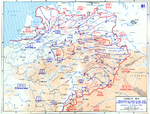Ruhr Campaign
Contributor: C. Peter Chen
ww2dbaseWith the natural obstacle of the Rhine River breached, instead of marching for the German capital of Berlin, Dwight Eisenhower instead chose to secure the industrious Ruhr region to eliminate threats on the British and Canadian armies' right flank. This region was the heart of the German steel and coal production, characterized with the headquarters of the Krupp manufacturing empire.
ww2dbaseIn the last week of Mar 1945, the Allied troops had already formed an envelopment around the region, with the American Ninth Army securing the north bank of the Ruhr, while the American First Army swept northeast from the Remagen bridgehead. George Patton and Courtney Hodges aimed their tank armies at the city of Münster, the headquarters of the German 6th Military District, which had already become shambles after consistent Allied bombings. Münster and surrounding regions were sacred ground to the German Army, guarded by veteran crews in Krupp-built tanks. There was little they could do, however, despite their valiant efforts. By 1 Apr, the Germans were overwhelmed, and Hamm on the Lippe and Lippstadt on the Ruhr became the locks that completed the envelopment, trapping approximately 350,000 German troops inside.
ww2dbaseAn Allied attack into the surrounded pocket region began on 2 Apr. The German garrison at the Ruhr region was commanded by Field Marshal Walther Model, who attempted to counterattack first to the north then the south; both attempts yielded little success. Omar Bradley continued to call for constant attacks on the enemy lines to assert pressure on this surrounded garrison, and by 14 Apr the German pocket was divided in two. On 16 Apr, the eastern half gave in to the pressure and surrendered, and two days later the western half did the same. 325,000 prisoners of war were taken, 30 of which were high ranking officers, making the fall of the Ruhr a greater disaster in the history of the German Army than Stalingrad, Russia in terms of German troops captured.
ww2dbaseSources:
Dwight Eisenhower, Crusade in Europe
William Manchester, The Arms of Krupp
Last Major Update: Jan 2007
Ruhr Campaign Mapa Interativo
Photographs
 |
Maps
 |  |
Ruhr Campaign Timeline
| 4 fev 1945 | The first of seven Ruhr dams in Germany was captured by the US First Army. |
| 7 fev 1945 | German demolition of Ruhr floodgates flooded the area west of Köln, Germany, inhibiting Allied action. |
| 9 fev 1945 | German engineers blew up the dam over the Ruhr, thereby presenting the US Ninth Army with an unbridgeable strip of surging water. This led to the attack from the south being postponed and the waters would not subside sufficiently for General William Simpson's leading troops to resume their advance until 23 Feb 1945. |
| 10 fev 1945 | US First Army captured the last of seven Ruhr dams in Germany, but in general Canadian and American troops continued to make very slow progress as key areas had been flooded by retreating Germans. |
| 7 mar 1945 | US First Army captured Köln (Cologne), Germany. |
| 24 mar 1945 | US 9th Army began to seal off the Ruhr region in Germany. |
| 1 abr 1945 | US First and Ninth Armies complete the encirclement of the Ruhr industrial area at Lippstadt, cutting off the 21 divisions (about 500,000 men) of the German Army Group B. |
| 3 abr 1945 | British Second Army arrived at Münster, Germany while the US Ninth Army captured Recklinghausen. |
| 5 abr 1945 | 18 US Divisions began to clear the Ruhr Pocket in Germany. |
| 11 abr 1945 | US Ninth Army captured Bochum, Essen, and Goslar, Germany. |
| 14 abr 1945 | The Ruhr Pocket was cut in two near Hagen, Germany. |
| 16 abr 1945 | US First Army captured Solingen and Wuppertal, Germany. |
| 17 abr 1945 | Field Marshal Model gave his remaining troops the choice of trying to get home, of trying to fight their way out of the Ruhr region in Germany, or of surrendering. Most chose to surrender. |
| 18 abr 1945 | Over 300,000 encircled German troops in the Ruhr region of western Germany surrendered. US First Army entered Düsseldorf. |
| 21 abr 1945 | At the end of the Ruhr battle in Germany, 325,000 Germans were taken prisoner. |
Você gostou deste artigo ou achou este artigo útil? Se sim, considere nos apoiar no Patreon. Qualquer valor já vai ajudar! Obrigado. Por favor, ajude-nos a divulgar o site: Fique atualizado com WW2DB: |

» Hodges, Courtney
» Model, Walter
» Patton, George
Location:
» Germany
- » 1,182 biografias
- » 337 eventos
- » 45,119 entradas na linha do tempo
- » 1,248 navios
- » 350 modelos de aeronaves
- » 207 modelos de veículos
- » 376 modelos de armas
- » 123 documentos históricos
- » 261 instalações
- » 470 resenhas de livros
- » 28,410 fotos
- » 365 mapas
Captain Henry P. Jim Crowe, Guadalcanal, 13 Jan 1943
Por favor, considere nos apoiar no Patreon. Mesmo R$1 por mês já faz uma grande diferença. Obrigado!
Ou, por favor, nos apoie adquirindo alguns produtos do WW2DB na TeeSpring. Obrigado!